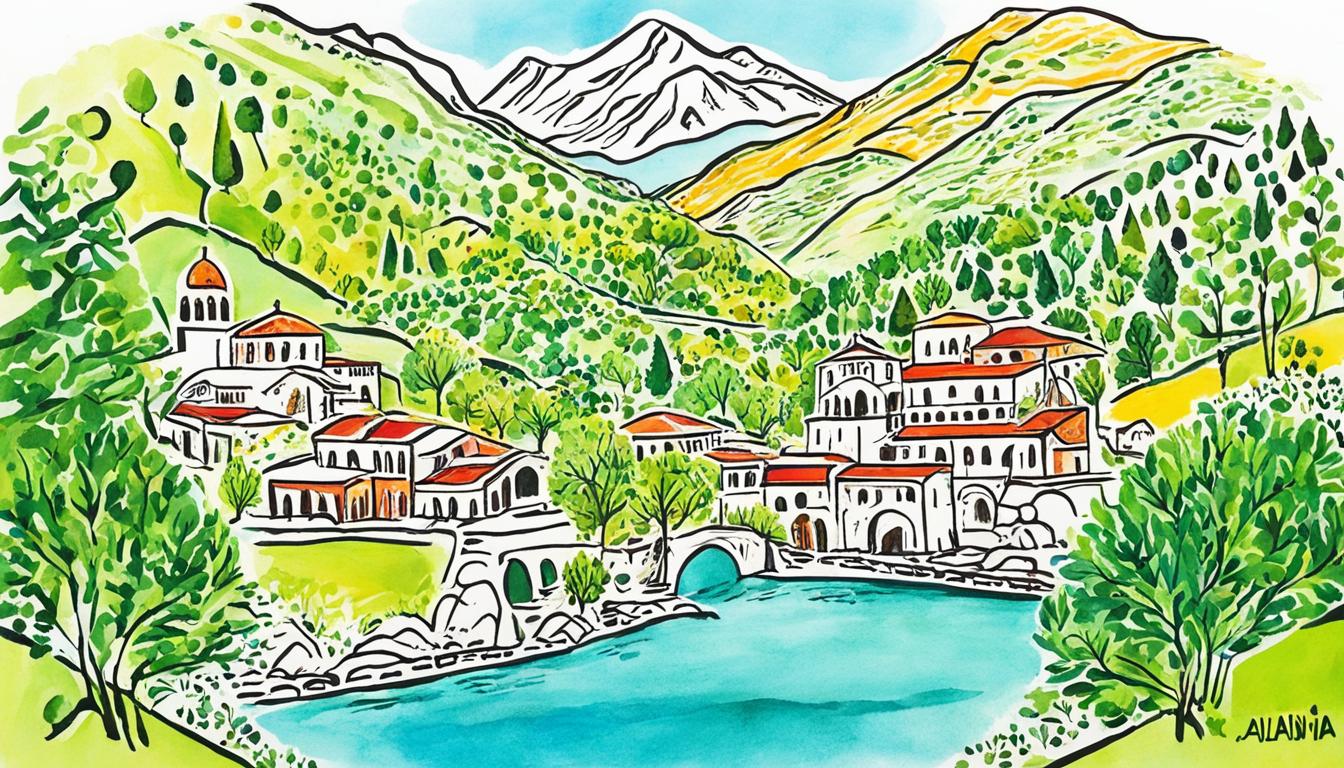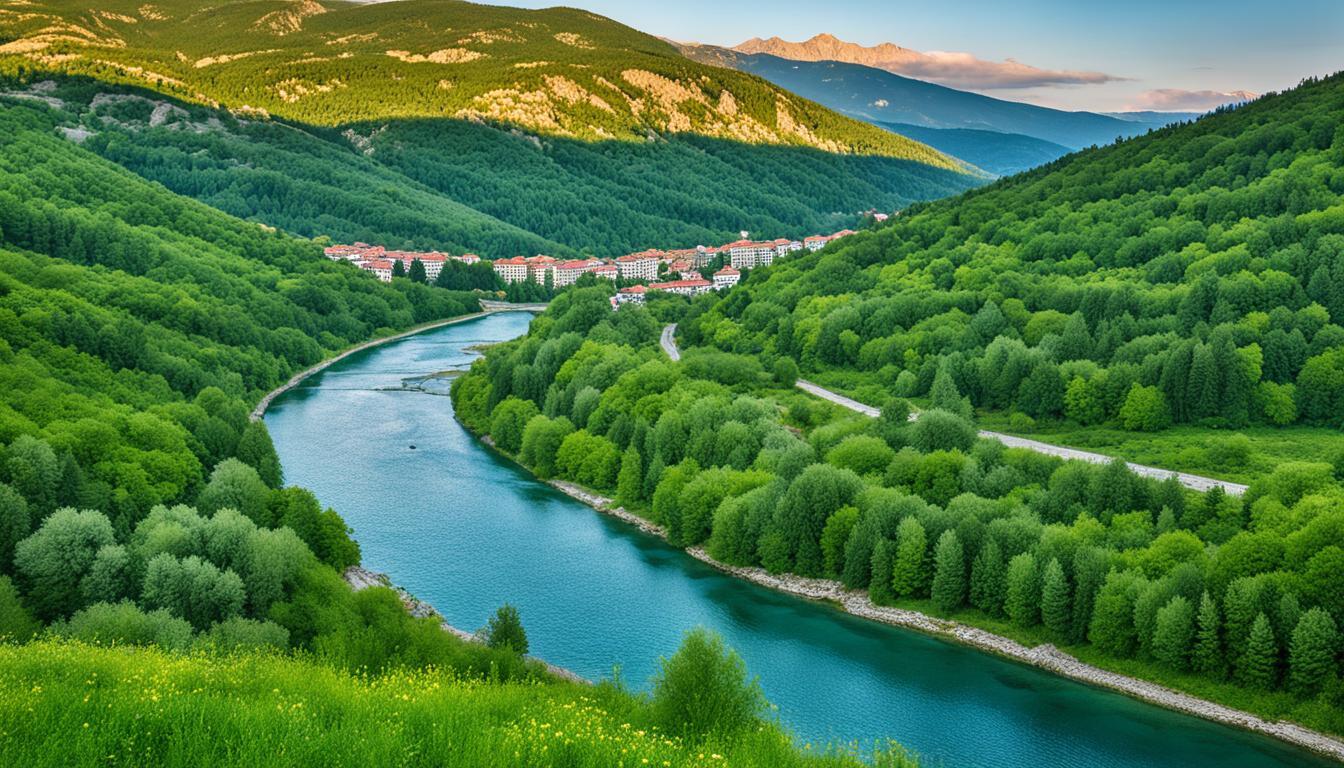Jordan Sacred Natural Sites and Biodiversity
Did you know that Jordan is home to some of the most culturally and environmentally significant sites on earth? With its stunning sacred natural landscapes and rich biodiversity, Jordan has become a hotbed for environmental conservation and cultural heritage preservation. These sites hold immense spiritual significance and are vital for the sustainable development of the country.
Key Takeaways:
- Jordan’s sacred natural sites are of great environmental conservation importance.
- Preserving biodiversity in sacred landscapes is crucial for sustainable development.
- Protected areas play a key role in conserving the natural and cultural heritage of Jordan.
- Eco-friendly tourism can contribute to the preservation of these sacred sites.
- The conservation of religious sites in Jordan is essential for their cultural and historical value.
The Master Plan for the Jordan River
The Master Plan for the Jordan River, unveiled in 2015, is a comprehensive strategy designed to address key water management issues and support the restoration of the river’s ecosystem. This plan is vital for combatting water scarcity and ensuring environmental conservation in the region.
Water scarcity poses a significant challenge for the Jordan River, with 98% of its water currently being drained and the river being used as a sewage canal. The Master Plan aims to tackle these issues through various restoration measures, allowing for the sustainable use of water resources and the preservation of biodiversity.
Under the Master Plan, one of the key focuses is on modernizing pipeline systems to prevent leakages and optimize water distribution. By implementing advanced technology, such as water-saving technologies, significant improvements can be made in water management practices, reducing waste and improving efficiency.
Promoting sustainable agriculture practices is another crucial aspect of the Master Plan. By encouraging farmers to adopt eco-friendly irrigation techniques and responsible water use, it becomes possible to minimize water consumption and preserve the scarce water resources of the Jordan River.
Ultimately, the implementation of the Master Plan for the Jordan River is a crucial step towards combatting water scarcity and ensuring the environmental conservation of this vital ecosystem. Through restoration measures and sustainable water management practices, the plan aims to protect the river’s biodiversity and support the long-term sustainability of the region.
Benefits of the Master Plan:
“The Master Plan for the Jordan River not only addresses pressing water management issues and restoration measures but also offers a pathway towards a more sustainable future. By implementing modern technologies and promoting responsible water use, we can protect the river’s biodiversity and guarantee the availability of water resources for future generations.” – Jordan Environmental Conservation Committee
| Restoration Measures | Water Management Strategies | Environmental Conservation Benefits |
|---|---|---|
| Modernizing pipeline systems | Preventing leakages and optimizing water distribution | Reduction in water wastage |
| Implementing water-saving technologies | Improving water management practices | Efficient use of water resources |
| Promoting sustainable agriculture practices | Encouraging responsible water use | Preservation of scarce water resources |
The Miyawaki Method for Forest Restoration
The Miyawaki method is a highly effective technique for forest restoration that aims to grow mature forests in a matter of decades using native vegetation. This method has been implemented in Amman, Jordan, with the goal of restoring disappearing forest ecosystems and reconnecting urban communities to nature.
The Miyawaki method involves planting native seedlings closely together, mimicking the natural growth patterns of forests. This dense planting technique promotes quicker and healthier growth, resulting in the rapid development of a forest ecosystem. By utilizing native vegetation, the method ensures that the restored forests are well-adapted to the local climate and support the biodiversity of the region.
Amman, Jordan, has already seen the successful implementation of the Miyawaki method in the establishment of three forests. These Miyawaki forests provide a range of ecological services, including the absorption of water, which helps mitigate flooding in urban areas, and the cooling of the surroundings, contributing to the mitigation of the urban heat island effect.
Furthermore, the Miyawaki forests in Amman provide habitat for local wildlife, enhancing biodiversity conservation efforts. The dense vegetation acts as a sanctuary for various species, helping to maintain and restore the natural balance of the ecosystem.
By utilizing the Miyawaki method, Amman, Jordan, is making significant contributions to biodiversity conservation. These restored forests not only provide crucial ecological benefits but also offer opportunities for residents to reconnect with nature and enjoy the natural beauty of their surroundings.
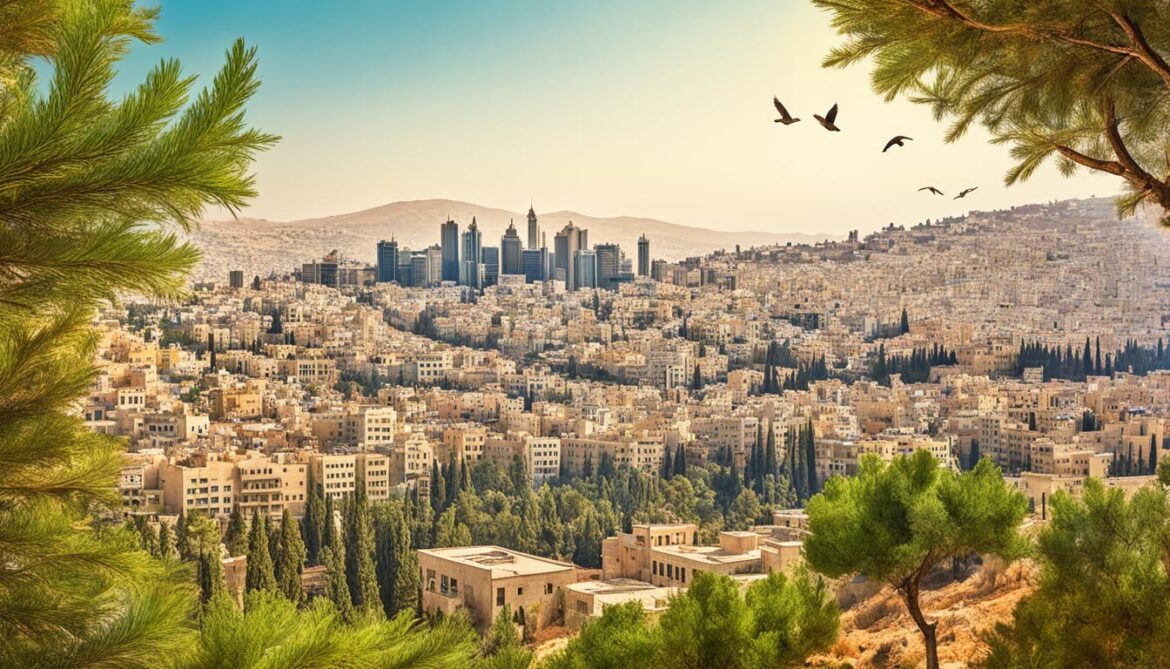
The success of the Miyawaki method in other countries has paved the way for its implementation in Jordan. This innovative approach to forest restoration demonstrates the transformative power of native vegetation and its role in preserving and enhancing the natural environment.
AES Jordan’s Biodiversity Assessment and Protection Procedure
AES Jordan, a leading company committed to sustainable practices, recognizes the significance of biodiversity conservation. As part of its commitment, AES Jordan has implemented a comprehensive Biodiversity Assessment and Protection Procedure. This procedure aims to assess and minimize the company’s impact on biodiversity, ensuring the long-term preservation of natural resources.
At AES Jordan, we understand the importance of responsible corporate environmental stewardship. Our Biodiversity Assessment and Protection Procedure includes an annual assessment of our biodiversity management activities. Through this assessment, we identify potential areas of improvement to minimize our environmental impact.
We also prioritize active communication and collaboration with stakeholders. As part of our procedure, we notify relevant parties of any future business actions that could potentially impact biodiversity. This ensures transparency and allows for inclusive decision-making processes to protect biodiversity.
In line with local regulatory requirements and industry standards, we are committed to complying with all applicable laws and regulations. Our procedure guarantees strict adherence to local regulatory requirements and demonstrates our commitment to environmental conservation.
The protection of biodiversity is at the core of our operational activities. Our procedure takes into account the ecological and biodiversity aspects to ensure responsible practices. This includes guidelines for mitigating and managing any potential impacts on biodiversity.
At AES Jordan, we understand that wildlife, ecosystems, and biodiversity are invaluable parts of our planet. Through our Biodiversity Assessment and Protection Procedure, we strive to be a champion for environmental conservation, aligning our actions with our commitment to sustainability. Together, we can protect and preserve biodiversity for a greener and more sustainable future.
Ecological Importance of the Jordanian Flora and Fauna
The flora and fauna of Jordan play a crucial role in maintaining the country’s biodiversity and ecological balance. The rich diversity of plant species supports various ecosystems and provides habitat for numerous animal species. From the majestic cedar trees in Ajloun Forest Reserve to the vibrant wildflowers of Wadi Rum, Jordan’s flora contributes to the country’s natural beauty and environmental sustainability.
Equally important is the fauna that inhabits these diverse landscapes. Jordan is home to a wide range of wildlife, including the Arabian Oryx, Nubian ibex, and Syrian wolf. These species are not only key indicators of a healthy ecosystem but also hold cultural significance for the local communities.
However, the biodiversity of Jordan is not without its challenges. Habitat loss, driven by urban development and agriculture expansion, poses a significant threat to many plant and animal species. Pollution, both air and water, further exacerbates the situation, impacting the delicate balance within ecosystems. Climate change, with its rising temperatures and changing rainfall patterns, adds another layer of complexity to the conservation efforts.
The Conservation Efforts
To address these challenges, Jordan is implementing various conservation efforts to protect and restore its flora and fauna. The establishment of protected areas, such as Dana Biosphere Reserve and Azraq Wetland Reserve, safeguards crucial habitats and provides a sanctuary for endangered species. These protected areas not only serve ecological purposes but also support research and education, contributing to the wider understanding of biodiversity conservation.
Conservation programs focused on preserving specific species, such as the critically endangered Arabian leopard or the vulnerable Nubian wild ass, play a vital role in safeguarding the genetic diversity within Jordan’s ecosystems. Through habitat restoration and population management, these programs aim to prevent the extinction of these unique and ecologically significant species.
Promoting sustainable practices is another essential aspect of Jordan’s biodiversity conservation efforts. Encouraging responsible land use, sustainable agriculture, and eco-friendly tourism helps minimize the negative impact on the environment and ensures the long-term viability of Jordan’s natural resources. By raising awareness about the ecological importance of the country’s flora and fauna, Jordan aims to foster a sense of stewardship among its citizens and visitors alike.
“The richness and diversity of Jordan’s flora and fauna are a testament to the country’s commitment to environmental conservation and sustainable development.” – Dr. Ahmad bin Hazeem, President of the Royal Society for the Conservation of Nature
The Way Forward
Preserving the ecological importance of Jordan’s flora and fauna is crucial for the long-term sustainability of the country’s natural resources. Continued efforts to protect and restore habitats, along with the implementation of conservation programs, are essential in securing a thriving biodiversity for future generations.
By integrating biodiversity considerations into land-use planning, strengthening environmental policies, and promoting sustainable practices, Jordan can ensure the coexistence of its human and natural ecosystems.
Conservation is a collaborative endeavor that requires the cooperation of government agencies, NGOs, local communities, and individuals. Through stakeholder engagement and a shared commitment to safeguarding biodiversity, Jordan can overcome the challenges it faces and create a more sustainable future for its flora, fauna, and people.
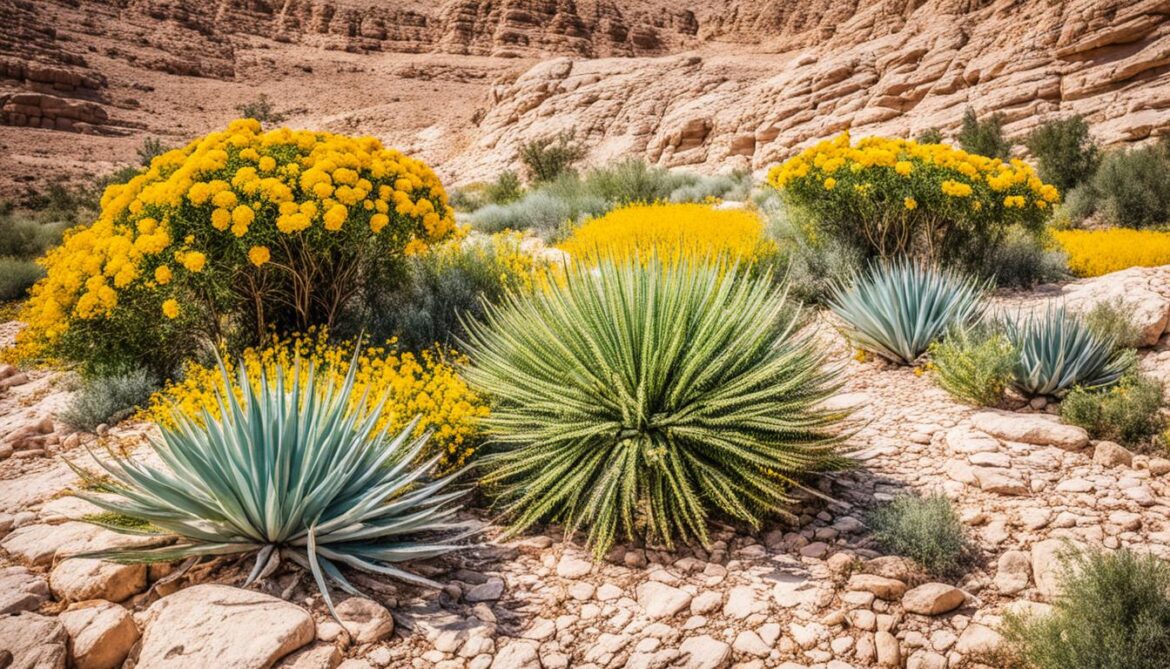
The vibrant landscapes of Jordan are home to a diverse range of flora and fauna.
Cultural Heritage Conservation in Jordan
Jordan is renowned for its rich cultural heritage, boasting numerous historical and archaeological sites that are scattered across the country. These sites serve as valuable artifacts, enabling us to preserve and honor the history of Jordan while promoting cultural tourism. Efforts are being made to safeguard and restore these sites through various initiatives, including the implementation of legal frameworks and regulations.
Preservation efforts aim to maintain the integrity and authenticity of these cultural treasures while ensuring public accessibility. It is essential to strike a balance between conservation and allowing visitors to experience the rich history and cultural significance of these sites.
Cultural heritage conservation plays a vital role in promoting sustainable development and preserving Jordan’s unique cultural identity. By protecting and promoting these historical and archaeological sites, Jordan can harness their potential as key drivers of economic growth and cultural enrichment for both local communities and visitors alike.
One notable example of cultural heritage preservation in Jordan is the ancient city of Petra, a UNESCO World Heritage Site. This remarkable archaeological site showcases the architectural marvels of the Nabataean civilization and attracts visitors from around the world. Efforts to conserve Petra’s intricate rock-cut structures and preserve its ecological surroundings are ongoing, ensuring that future generations can continue to admire and appreciate this iconic historical site.
“Preserving our cultural heritage is not just about safeguarding historical artifacts; it is about protecting the stories, traditions, and identity of our people.” – Queen Rania of Jordan
Through the preservation of historical and archaeological sites, Jordan is not only safeguarding its past but also shaping its future. Cultural heritage conservation contributes to sustainable tourism, economic development, and the overall well-being of the nation. It allows us to connect with our roots, celebrate our shared heritage, and foster a sense of community and pride. Our collective commitment to cultural heritage preservation ensures that future generations can appreciate and learn from the rich tapestry of Jordan’s history.
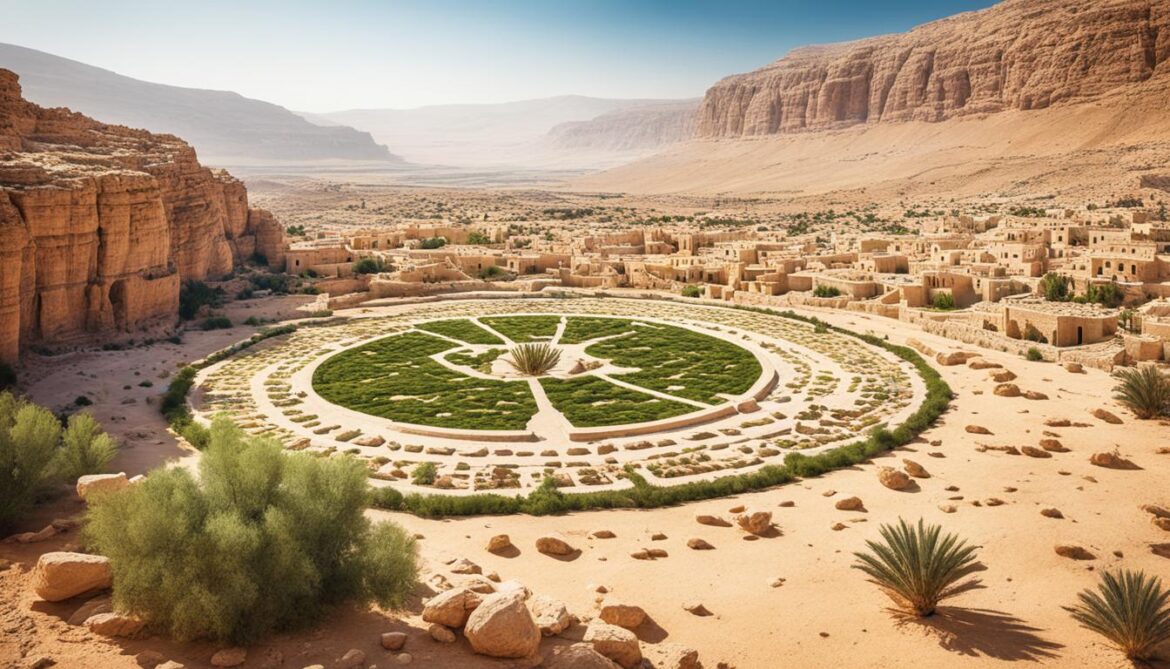
Cultural Heritage Conservation Initiatives in Jordan
| Initiative | Description |
|---|---|
| Legal Frameworks | Implementation of laws and regulations to protect historical and archaeological sites from destruction, vandalism, and illegal excavation. |
| Restoration Projects | Efforts to restore and preserve decaying structures and artifacts, ensuring their structural integrity and long-term survival. |
| Education and Awareness | Public programs and campaigns to raise awareness about the value of cultural heritage and the importance of its preservation. |
| Tourism Management | Developing sustainable tourism practices that minimize the impact on historical sites while maximizing their economic and cultural benefits. |
Cultural heritage conservation in Jordan goes beyond the mere preservation of physical sites; it is about protecting the stories, traditions, and identity of the Jordanian people. By embracing and safeguarding our cultural heritage, we ensure that future generations can continue to be inspired by the past and celebrate the rich and diverse tapestry of Jordan’s history.
The Role of Eco-Friendly Tourism in Biodiversity Preservation
Eco-friendly tourism plays a critical role in promoting biodiversity preservation and sustainable travel practices. By adopting responsible tourism approaches, travellers can minimize their impact on the environment while contributing to the conservation of natural habitats and species. In Jordan, the promotion of eco-friendly tourism initiatives is instrumental in raising awareness about the country’s rich biodiversity and cultural heritage.
Eco-friendly tourism allows visitors to experience the beauty of Jordan’s sacred natural sites while actively participating in their long-term preservation.
Sustainable tourism practices encompass various aspects, including responsible waste management, energy conservation, and supporting local communities. By reducing waste and implementing sustainable waste disposal methods, eco-friendly travellers minimize their environmental footprint. Energy conservation measures, such as using renewable energy sources and minimizing energy consumption, further contribute to the conservation of natural resources.
Supporting local communities is an essential component of eco-friendly tourism. By engaging with local businesses, travellers can contribute to the socio-economic development of the region while ensuring that tourism benefits are shared equitably. This support enables local communities to become active stakeholders in biodiversity preservation efforts.
Preserving Jordan’s Sacred Natural Sites Through Responsible Travel
Eco-friendly tourism initiatives promote responsible travel practices that align with biodiversity preservation goals. These initiatives encourage travellers to respect the natural environment, adhere to trail and park rules, and engage in educational activities that highlight the importance of conserving biodiversity.
By choosing eco-friendly travel options, such as low-impact transportation, sustainable accommodations, and ethical tour operators, visitors can minimize their environmental impact and actively contribute to biodiversity preservation. Low-impact transportation options, such as cycling or walking, not only reduce carbon emissions but also allow travellers to immerse themselves in the natural surroundings.

Eco-friendly tourism also emphasizes the importance of preserving ecosystems and protecting wildlife. Visitors are encouraged to follow designated trails, maintain a safe distance from wildlife, and avoid disturbing their natural habitats. By respecting these guidelines, travellers can ensure the long-term viability of biodiversity-rich areas.
Education and awareness play a crucial role in the success of eco-friendly tourism initiatives. Visitors can engage in educational activities, such as guided nature tours and informative signage, to learn about the local flora, fauna, and conservation efforts. This knowledge fosters a deeper appreciation for biodiversity and encourages travellers to become ambassadors for responsible tourism practices.
“Eco-friendly tourism allows travellers to enjoy the beauty of nature while actively participating in its long-term preservation.”
Collaborative Efforts for Biodiversity Preservation
Biodiversity preservation requires collaboration among various stakeholders, including governments, local communities, and tourists. Governments play a crucial role in implementing policies and regulations that promote eco-friendly tourism practices and protect natural habitats. They can support initiatives such as the establishment of protected areas and the enforcement of sustainable tourism guidelines.
Local communities are vital partners in biodiversity preservation efforts. Regulations that support community-based tourism empower local residents to actively participate in the conservation of their natural and cultural heritage. By involving local communities in the planning and management of tourism activities, their traditional knowledge and practices can be preserved and integrated into sustainable tourism initiatives.
Tourists themselves have the power to make a positive impact on biodiversity preservation. By choosing eco-friendly travel options and supporting responsible tourism practices, they actively contribute to the conservation of natural habitats and species. Their actions not only minimize environmental impact but also support local economies and foster awareness among fellow travellers.
Challenges and Opportunities for Biodiversity Conservation in Jordan
Biodiversity conservation in Jordan faces various challenges that threaten the country’s natural heritage and ecological balance. Habitat loss, pollution, and climate change all pose significant threats to the diverse plant and animal species found in Jordan’s ecosystems. These challenges require collaborative efforts from government agencies, NGOs, and local communities to address and mitigate their impact on biodiversity.
However, amidst these challenges, there are also ample opportunities for biodiversity conservation in Jordan. By embracing sustainable development practices, the country can protect its natural resources while promoting economic growth and social well-being.
Opportunities for Biodiversity Conservation
One key opportunity lies in the promotion of eco-friendly tourism. By encouraging visitors to engage in responsible travel practices, Jordan can leverage its rich biodiversity to attract tourists who are conscious of their environmental impact. This can create economic opportunities for local communities while supporting the conservation of natural habitats and species.
Another opportunity for biodiversity conservation is the establishment of protected areas. By designating specific regions as protected areas, Jordan can ensure the preservation of critical habitats and contribute to the recovery and expansion of endangered species populations.
Furthermore, the implementation of comprehensive conservation programs can play a vital role in preserving Jordan’s biodiversity. These programs can prioritize research, monitoring, and conservation efforts to address specific conservation challenges and protect vulnerable species and habitats. Collaborative initiatives involving scientists, conservationists, and local communities can provide valuable insights and innovative solutions for effective biodiversity conservation.
Challenges in Biodiversity Conservation
Despite these opportunities, challenges persist in the conservation of biodiversity in Jordan. Habitat loss due to urbanization, agriculture, and infrastructure development continues to degrade and fragment natural landscapes, threatening the survival of many species.
Pollution, particularly from industrial activities and inadequate waste management, poses additional challenges to biodiversity conservation efforts. Pollution affects both terrestrial and aquatic ecosystems, leading to the decline of species and the degradation of their habitats.
Climate change exacerbates these challenges by altering the conditions necessary for the survival and reproduction of many species. Rising temperatures, changing rainfall patterns, and increased frequency of extreme weather events can disrupt ecological processes and impact the distribution and abundance of wildlife.
Additionally, effective biodiversity conservation requires the collaboration of various stakeholders, including government agencies, NGOs, local communities, and businesses. Overcoming barriers to stakeholder collaboration, such as conflicting interests and limited resources, is essential in implementing coordinated strategies and actions for conservation.
In summary, biodiversity conservation in Jordan faces both challenges and opportunities. By recognizing the significance of biodiversity and working together, stakeholders can create a sustainable future that protects and preserves Jordan’s natural and cultural heritage for future generations.
The Importance of Public Awareness and Education
Public awareness and education are vital components in the conservation of biodiversity and the promotion of environmental stewardship. By increasing awareness about the importance of biodiversity, individuals can develop a deep appreciation for the natural world and become active participants in conservation efforts. Education programs and initiatives play a crucial role in equipping communities with the knowledge and skills needed to protect and preserve the biodiversity of Jordan.
One of the key goals of public awareness campaigns is to communicate the value of biodiversity and highlight the interconnectedness of all living organisms. These campaigns raise awareness about the threats facing biodiversity, such as habitat destruction, climate change, and pollution, and emphasize the importance of taking action to address these challenges.
“Biodiversity is not just about saving tigers or pandas; it’s about preserving the web of life that sustains us all.” – David Suzuki
Public awareness campaigns can take various forms, including media campaigns, workshops, and community engagement activities. These initiatives aim to inspire individuals to become environmental stewards and protectors of biodiversity. They encourage people to adopt sustainable practices in their daily lives, such as reducing waste, conserving water and energy, and supporting businesses that prioritize environmental sustainability.
In addition to awareness campaigns, interpretive signage and educational materials at national parks and protected areas can provide visitors with valuable information about the local flora, fauna, and ecosystems. These educational resources help visitors understand the importance of biodiversity conservation and encourage them to act responsibly during their visits.
Furthermore, incorporating biodiversity-related topics into school curricula fosters a sense of environmental responsibility in young minds. By educating students about the value of biodiversity and the link between human well-being and ecological balance, educational institutions contribute to the development of environmentally conscious individuals who are passionate about biodiversity conservation and environmental stewardship.
Inspiring Action through Public Awareness and Education
Public awareness and education efforts create a sense of ownership and responsibility among individuals, empowering them to take action and make a positive impact on biodiversity conservation. Through these initiatives, communities can actively participate in conservation projects, volunteer for environmental organizations, and support policies and practices that promote biodiversity preservation and sustainability.
By fostering a culture of environmental stewardship through public awareness and education, Jordan can secure a sustainable future for its unique natural heritage and contribute to global efforts in biodiversity conservation.
Summary of the Importance of Public Awareness and Education
Public awareness and education are critical for biodiversity conservation and environmental stewardship. By increasing awareness and providing education about the value of biodiversity, individuals can become active participants in conservation efforts. Public awareness campaigns, interpretive signage, and educational programs inspire individuals to adopt sustainable practices and foster a sense of ownership and responsibility for biodiversity preservation. Through public awareness and education, communities can make a lasting impact on biodiversity conservation in Jordan.
Conclusion
The preservation of Jordan’s Sacred Natural Sites and Biodiversity is vital for the sustainable development of the country. These sites hold significant cultural and environmental value, making their conservation a shared responsibility. The implementation of the Master Plan for the Jordan River and the adoption of the Miyawaki method for forest restoration play essential roles in safeguarding the country’s natural resources.
By embracing eco-friendly tourism, promoting cultural heritage conservation, and raising public awareness and education, Jordan can ensure the long-term protection of its Sacred Natural Sites and Biodiversity. These concerted efforts will pave the way for future generations to enjoy and benefit from the rich ecological and cultural heritage of the country. It is through these collaborative actions that Jordan can achieve sustainable development and effective biodiversity conservation.
In summary, the preservation of Jordan’s Sacred Natural Sites and Biodiversity requires the collective commitment of stakeholders across various sectors. With the Master Plan for the Jordan River and the Miyawaki method as guiding principles, supported by eco-friendly tourism, cultural heritage conservation, and public awareness and education initiatives, Jordan can create a sustainable future that cherishes its unique natural and cultural treasures.






